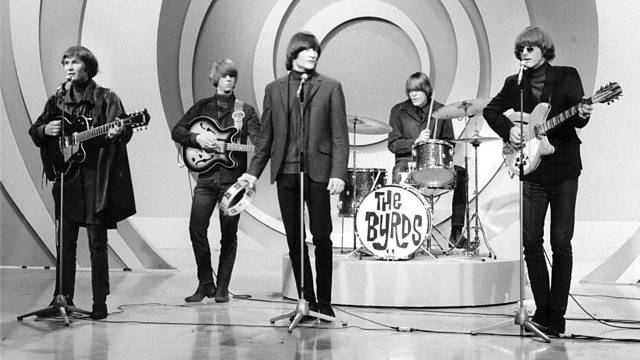An infinite number of tracks can each be THE greatest record ever made, as long as they take turns. Today, this is THE GREATEST RECORD EVER MADE!
THE BYRDS: Eight Miles High
Written by Gene Clark, Jim McGuinn, and David Crosby
Produced by Allen Stanton
Single, Columbia Records, 1966
The Byrds formed in '64, a quintet of (mostly) folk musicians, with résumés that listed stints with the likes of the Chad Mitchell Trio, the New Christy Minstrels, and Bobby Darin. But folk wasn't necessarily all they really wanted to do; not in 1964. The British Invasion was underway. The five lads who would become the Byrds saw A Hard Day's Night and went electric, in mind and in fact. America needed its own Beatles. Byrdsmania? Well...why not? In 1965, the Byrds effectively became America's answer to England's Fab Four.
But in between their two chart-toppers in 1965, the Byrds' cover of Bashful Bob Dylan's "All I Really Want To Do" barely made the Top 40, unable to match the popularity of a competing version by Cher. Still, with the late-year success of "Turn! Turn! Turn!," the Byrds seemed to be cruising at their proper level of high.
They would never break into the Top 10 again.
A relative lack of subsequent top-of-the-pops sales doesn't reflect the quality of the Byrds' material in 1966. If anything, the group continued to grow, to expand their vast horizons, to mature in ways previously inconceivable for a pimply-hyperbole pop combo. It was 1966. Anything could happen in 1966, even more so than in '65. And in 1966, the Byrds created their enduring masterpiece, "Eight Miles High."
"Eight Miles High" is an immersive psychotropic experience, and everyone thought it was about drugs. Drugs may have fueled its genesis, but its scope and ambition are so, so much above and beyond such a limited topic. The song began as notes scribbled by Gene Clark, reflecting upon the weird environment of the Byrds' first visit to England in '65. The title refers to the altitude of a passenger jet soaring over the Atlantic, changed with poetic license from the real-world number of about six miles o'er the sea to the snazzier-sounding eight-mile figure. Eight miles HIGH? A coincidence, even at the dawn of that psychedelic period. Just say no, kids.
Nowhere is there warmth to be found
Among those afraid of losing their ground
Rain gray town, known for its sound
In places, small faces unbound
The Byrds' tour of Blighty had been off-putting, stranger than known. It's said that the group didn't play particularly well for those shows, and the British rock press was openly hostile to these Yanks who seemed to compare themselves to the four kings of EMI. America's answer to the Beatles?! The critics sneered in response. The trip did not go well.
Many years later, David Crosby decried the breathless lunacy of the Beatles comparison, insisting that the Byrds on their best day weren't as good as the Beatles. But make no mistake: with "Eight Miles High," the Byrds were eight steps ahead of anyone else.
The music was inspired by Crosby's Ravi Shankar and John Coltrane tapes--Indian classical music and free jazz!--a distinctive and unusual pair of influences for a friggin' pop single in early 1966. The recording conveys heaviness, density, and compressed, daunting hints of acrophobia, agoraphobia, and liberation. The track is both of the moment and jarringly ahead of its time. It predicts the new wave vertigo of Television's "Elevation" in 1977. Hüsker Dü's 1984 thrash-pop bludgeoning of "Eight Miles High" is somehow faithful in its own mutant way, not at all iconoclastic, nor the tiniest speck wilder than the Byrds' original. The sheer audacity of the Byrds' sound and vision on "Eight Miles High" was unprecedented in this giddy field of rockin' pop music. At the time, not even the Beatles nor Brian Wilson had gotten quite that far out. Yet. They'd get there in '66.
The Byrds got there first.
In America, guardians at the gate of moral propriety insisted "Eight Miles High" was a drug song and nothing more; the dead certainty of their closed minds limited the single's airplay, and weighted down its chart ascension. It still managed a more than respectable showing of # 14 on Billboard's Hot 100. It was the Byrds' last Top 20 single.
Gene Clark left; ironically, the Byrd whose own creative spark initiated the song "Eight Miles High" was himself afraid of flying. Michael Clarke left. Crosby left, a very public departure. None of these partings was amicable. By the end of 1967, only McGuinn and Hillman remained from the original line-up once touted as America's answer to the Beatles. Hillman split in late '68. McGuinn--by then called Roger McGuinn--was the only constant member in all incarnations of the Byrds.
And there are works of giddy delight and substantive wonder in each of those incarnations. From "I'll Feel A Whole Lot Better" through "So You Want To Be A Rock And Roll Star" through Sweetheart Of The Rodeo through "Chestnut Mare" through even the much-maligned 1973 reunion of the original five guys, the Byrds' recording career is marked by a plethora of dizzying, euphoric highs.
One song flew a little bit higher than the others.
If you like what you see here on Boppin' (Like The Hip Folks Do), please consider supporting this blog by becoming a patron on Patreon, or by visiting CC's Tip Jar. Additional products and projects are listed here.
This Is Rock 'n' Roll Radio with Dana & Carl airs Sunday nights from 9 to Midnight Eastern, on the air in Syracuse at SPARK! WSPJ 103.3 and 93.7 FM, and on the web at http://sparksyracuse.org/ You can read about our history here.









Excellent piece.
ReplyDelete